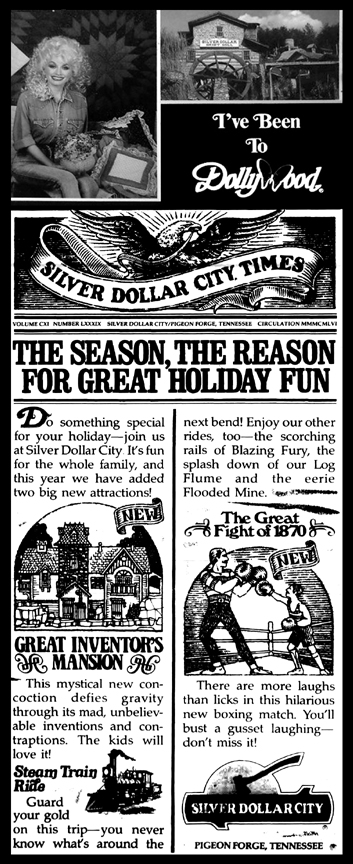The recent announcement by Dolly Parton that a $300M expansion was coming to Dollywood prompted today's column. Dolly's dream park evolved over a duration of 25 years through a series of ownership and business name changes.
The earliest offering, Rebel Railroad, was built to compete with the successful Tweetsie Railroad park that was located between Boone and Blowing Rock, NC. Next came Goldrush Junction, Goldrush and Silver Dollar City, the latter being a 75-acre venture that opened in 1977 in Pigeon Forge, Tennessee.

Many people recall when Silver Dollar City was in its prime. In 1978, after the park increased in size by 33%, it announced that it needed singers, musicians, actors, actresses and dancers. It boasted of more attendance that year than most New York City Broadway shows.
In 1980, more than 75 professional craftsmen demonstrated old-time skills during their Fourth Annual National Crafts Festival. The event brought an 80% increase in attendance from the previous year. Crafts ranged from the functional to the ornamental, with emphasis on being “one of a kind.”
A year later, the park began actively hiring senior citizens to augment the work force. These individuals were ideally qualified for making decorative crafts and working with vintage machinery. The park also began promoting “Older American Days” during the month of September; guests 55 and older were admitted at a reduced admission price.
The “City's” 1982 Sixth Annual National Crafts Festival in autumn of that year featured some of the best pioneer craftsmen in the breathtaking setting of the Smoky Mountains. This included authentic steam sawmill operation, glassblowing, grain threshing, cider making, needlepoint, wheat weaving, toile painting , doll making and more.
In 1986, Dolly Parton became a partner of the business with impressive ideas for the park. She commented that she always yearned to change the first letter on the famous “Hollywood hillside sign in California to make it “Dollywood.” The park acquired that name on May 1, 1986. Over the next quarter century, the impressive venture doubled to 150 acres with 10 secondary theme areas.
When Parton left the hollows of the Smoky Mountains where she was born, the most exciting ride in town was the family horse. Twenty years later, East Tennessee and Dolly had changed. New attractions, included “River Rampage,” an artificial version of white-water rafting, and a steam locomotive that chugged through the surrounding park thrilling the passengers.
In a news conference at the park opening, Dolly said, “East Tennessee gave me life, enthusiasm and inspiration. And it's good if you can give something back. I was born a dreamer and I love the Smoky Mountains. I think it's a very beautiful place for someone with a creative mind.”
The singer/actress was especially pleased that her new business provided employment for the community surrounding where she was born. She said her favorite part of the site was a museum of souvenirs taken from her life, including the “coat of many colors” that she wore as a child, which inspired a song of the same name. Every time she went in the building, it was like looking back at her life.
Dolly's museum did not contain the three-room cabin where she once lived because its present owner would not part with it. Subsequently, Dolly recreated the cabin as Parton's Back Porch Theater and used it for stage shows. The new owner said she planned to spend as much time as possible at the park during its first summer.
Tourism officials estimated that Dollywood would draw a million visitors a year, compared to a half million that Silver Dollar City park drew its last year. Dolly's influence was significant because of her drive and the fact that she spoke the same language as the people who lived there.
Dolly Parton, the local girl who hit it big, did not forget her humble roots and the fact that she was brought into this world by a mountain doctor who was paid only a bag of cornmeal for his work.

Comments are closed.